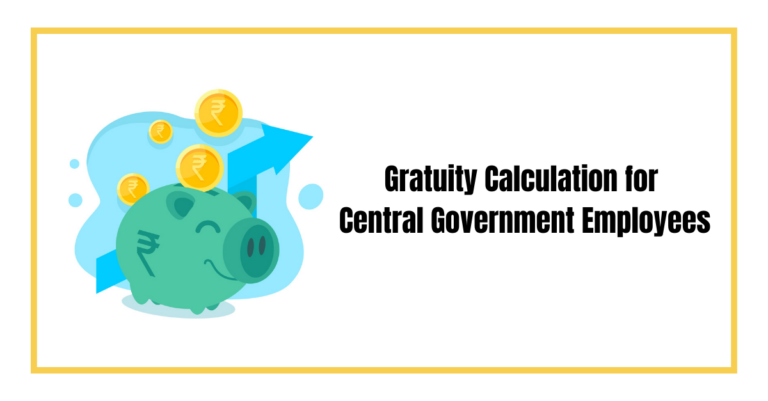You can calculate gratuity using an online gratuity calculator. You can withdraw gratuity by completing the gratuity claim form I. Read this article to know how to do this step by step.
You can use a gratuity calculator to know the amount you are liable to receive. Gratuity is a component of a person’s salary. It is one of the components that make up an individual’s gross salary. In other words, Gratuity meaning it is a sum of money paid to an employee at the end of his or her employment term. It is a type of recognition given to an employee for the services he has provided. This benefit is provided by the Payment of Gratuity Act of 1972. Although it is payable upon retirement, depending on the terms and conditions, it can be paid to the employee in advance. The individual must have served in an organisation for at least five years. It can be paid before the five-year mark if the employee dies or suffers from a disability or illness. Let’s see how to calculate and withdraw gratuity amount.
How Does Gratuity Payment Work?
In some cases, the employer pays his employees out of his own pocket, while in others, they work with insurance providers to set up group gratuity plans. It is also possible for an employee to contribute to his or her gratuity amount. The insurance company’s gratuity is determined by the clauses attached to the group insurance scheme.
Payment of Gratuity Act, 1972
This act was passed in 1972 to cover employees working in factories, mines, oil fields, plantations, ports, companies, and establishments employing more than ten people. According to the act, the gratuity amount is to be paid entirely by the employer, with no contribution required from the employee.
Let’s walk through the rules and regulations of gratuity.
- According to the Payment of Gratuity Act of 1972, an employee is only eligible for a gratuity after working for an organisation for at least five years. The employee will receive the gratuity amount as part of his or her superannuation, or when he or she retires or resigns
- It should be noted, however, that there is an exception where the requirement of working for a firm for five years in a row does not apply
- If an employee becomes disabled or dies, the employer is required by law to pay the gratuity to the employee or his or her nominee, regardless of the number of years of continuous service
- The law also states that if the nominee is a minor, the assistant labour commissioner will invest the funds in his or her name in a term deposit with a nationalised bank for the minor’s benefit until he or she reaches the age of majority
- There are rules that must be followed during the payment process. The rules state that if an employee is eligible for gratuity, he or she must apply within 30 days of the date it becomes payable
- If the date of superannuation or retirement is known, the application can be submitted before the 30-day deadline
- An employer, on the other hand, is not permitted to reject an employee’s application after the 30-day period has expired if the delay is due to a valid reason
- The rules also state that no claim for gratuity shall be deemed invalid simply because the individual did not file his or her application within the specified time frame.
Eligibility Criteria for Receiving Gratuity Amount
The employee is eligible for a gratuity if the following conditions are met:
- The employee must be entitled to superannuation
- The employee should have retired years ago
- After 5 years with the same employer, the employee must have resigned
- The employee dies or becomes disabled as a result of an illness or accident.
Calculation of Gratuity Amount
You can use a gratuity calculator to know the amount you are liable to receive. The gratuity amount is calculated using a number of factors. This amount is also determined by the length of time one has worked for the company as well as the most recent salary received.
Consider the following:
N denotes the number of years spent with the company. B = basic last-drawn salary plus DA Then, gratuity equals N x B x 15/26.
If an employee has worked for an organisation for 15 years and his last drawn basic + DA amount is ₹ 30,000, his gratuity is 1530,00015/26 = ₹ 2,59,615.38.
Consider the following:
- Gratuity is similar to a tip, the employer may choose to pay a higher amount. However, it should not be more than ₹ 10 lakhs.
- Ex-gratia refers to any amount in excess of ₹ 10 lakhs. It is not mandated by law and is entirely voluntary.
- A time span of more than 6 months in the last year of employment is rounded off to the next number, whereas a time span of fewer than 6 months is not; for example, if an employee has worked for a company for 7 years 8 months, he is entitled to 8 years gratuity, whereas if he has worked for 7 years 4 months, he is entitled to 7 years gratuity only.
Advantages of Using Gratuity Calculator
The benefits of utilizing a Vakilsearch Gratuity Calculator are numerous:
- Accurate Calculation The Vakilsearch Gratuity Calculator ensures precise calculations, allowing users to determine gratuity amounts with confidence.
- User-Friendly Interface The calculator is designed with a user-friendly interface, making it easy for individuals to input relevant information and obtain gratuity calculations effortlessly.
- Transparent Process Vakilsearch’s Gratuity Calculator follows a transparent process, providing users with clarity on how the gratuity amount is computed based on the specified parameters
- Legal Compliance The calculator takes into account the maximum gratuity limit set by legal regulations, ensuring that the calculated amount aligns with statutory requirements.
- Time-Saving Users can swiftly assess gratuity amounts without the need for manual calculations, saving time and effort.
- Accessibility The calculator is accessible through the Vakilsearch platform, allowing users to conveniently access and use it anytime, anywhere.
Maximum Gratuity Limit
The maximum gratuity limit refers to the upper cap imposed by applicable laws on the amount of tax-free gratuity that can be received by an employee from their employer. Gratuity is a statutory benefit provided by employers to employees as a token of gratitude for their long-term service. In many jurisdictions, including India, there are specific rules and regulations governing the calculation and payment of gratuity, and these often include a maximum limit.
In India, the maximum limit for gratuity is governed by the Payment of Gratuity Act and the Income Tax Act. According to the Act, the maximum amount of tax-free gratuity is ₹20 lakhs.
It’s important to note that the maximum gratuity limit can be revised by the government, so it’s advisable to check for the most recent updates or amendments to ensure accurate and current information.
How to Withdraw Gratuity Amount?
Withdraw Gratuity Amount: Employees can claim their gratuity amount by completing the Gratuity Claim Form I. On the gratuity form I, write all of the required information, such as the claimant’s full name, address, department in which you worked, employee id number, date of appointment, cause of termination, total service period, and last drawn salary. Sign the gratuity claim form after filling it out. You can use a gratuity calculator online to know the amount you are liable to receive.
Tax Process of Gratuity
The process of gratuity taxation is dependent on the recipient of the gratuity amount. There are two main scenarios for this:
- When a government employee receives his or her gratuity: If the employee works for the state, the federal government, or a local government and receives a gratuity, the amount is fully exempt from income tax
- When a salaried employee receives a gratuity payment from a covered employer: If the employee’s employer is covered by the Gratuity Act: https://clc.gov.in/clc/acts-rules/payment-gratuity-act, the following amount is tax-free: 15 days’ salary based on the employee’s most recent paycheck
- When a salaried employee receives a gratuity from an employer who is not covered by the act, the lesser of the following amounts is exempt from tax: ₹ 10,00,000 or a gratuity received by the employee, or half a month’s salary, for each year of service with his employer.
Important Rules
Let’s walk through the important rules of gratuity.
Forfeiture
According to the Payment of Gratuity Act of 1972, the employer may forfeit the payment of gratuity. Even if the employee has completed 5 or more years of service with the company, this can be partial or total. This may occur if the employee is terminated due to his disorderly conduct while on the job and physically harms others.
Payment Timeline
The three major payment steps are as follows:
- Initiation: The employee must send the application to the employer in relation to the company’s gratuity owed to him or her
- Acknowledgement and calculation: After receiving the application, the company that owes the gratuity calculates the amount and sends a notice to the employee and controlling authority with the specified amount
- Disbursement: After receiving the acknowledgement, the employer has 30 days to pay the gratuity amount.
Tax Exemptions
The gratuity laws have changed slightly as a result of policy changes made in the 2016 budget. Here are the main points:
- Gratuity received by government employees, other than statutory corporations, is fully exempt from tax under Article 10(10)i of the Income Tax Act
- According to Article 10(10)ii of the Income Tax Act, the employee’s retirement and death gratuity under the act is the smallest amount of the following options, which is tax-free:
- (15/26) x Last drawn salary x Completed year of service or part in excess of 6 months (7 days if the employee belongs to a seasonal establishment)
- ₹ 10 lakhs
- Actual gratuity amount received
- According to Article 10(10)iii of the Income Tax Act, the gratuity amount received by employees who are not covered by the act is exempt as follows:
- Half month’s average salary X Completed years of service
- ₹ 10 lakhs
- Actual gratuity received.
Conclusion
When receiving a gratuity from an employer, if the amount exceeds INR 10,00,000, the tax exemption is calculated based on the points highlighted in the taxation section above. An employer may refuse an employee’s gratuity payment if the employee has been told to leave the organisation due to their misconduct. If an employee passes away, the gratuity is paid to their heir or nominee. However, the tax must be calculated under the heading Income From Other Sources as well. Hope this blog related to Calculate and Withdraw Gratuity Amount was helpful!
Also, Read:










